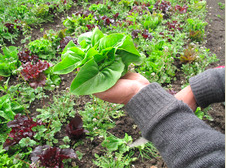QUESTION: Are the significantly higher prices for organic groceries justifiable? What makes them cost more (sometimes much more) than regular groceries? Some people can’t afford the difference. Asked by Joan O’Henley, Oakland, Calif.
ANSWER: Organics are expensive. I cooked for myself most of last year, and this obviously involved regular trips to the grocery store. Out of a desire to eat healthy, I’d always make a beeline for the produce section. But on a student budget, I would always be sad that I couldn’t afford the high price of organic produce. But it turns out you can be strategic: there are some items that are definitely worth paying more for to get the organic version, and others where you can save your money and buy conventional.

Organics are expensive because of the cost of production compared to conventionally grown products. Growing any food requires buying seeds, pesticides and fertilizers, and farm equipment, paying laborers and transporting the produce to market. Organic farms end up paying more in almost every category. You can find a more complete breakdown of the production costs of organic food in the Nitty-gritty answer.
There are two main reasons to consider buying organic—better health for you, and better health for the environment. And those benefits can vary by product. Some organics really are better for your health, and some aren’t, and some conventional crops are harder on the planet than others. The reasons may surprise you—but having the information can help you make smart decisions about buying organic.
Toxic residues are a primary health concern of conventional farming. All those pesticides that so successfully keep bugs from eating the produce can end up on, or in, the fruits and vegetables for us to ingest. In order to maintain pesticide consumption at or below the EPA’s recommended levels, many people are turning to organics. Every year the Environmental Working Group, a non-profit organization, tests produce for pesticide residue. It publishes the “Dirty Dozen” list with its findings. This list ranks non-organic produce by the types and amount of pesticides found on them. Apples topped the list in 2011 with the most pesticides. Produce on this list will give you the most “bang for your buck” if you go organic. The working group also releases the “Clean Fifteen,” which highlights produce that, when conventionally grown, has the least pesticide residue. While there’s no guarantee that the using the lists as a guide will keep your diet pesticide free, following them will definitely reduce your pesticide intake, and help keep your produce budget manageable.
The Dirty Dozen — Buy these organic
Apples
Celery
Strawberries
Peaches
Spinach
Nectarines – imported
Grapes – imported
Sweet bell peppers
Potatoes
Blueberries – domestic
Lettuce
Kale/Collard greens
The Clean 15 — Lowest in pesticides
Onions
Sweet corn
Pineapples
Avocado
Asparagus
Sweet peas
Mango
Eggplant
Cantaloupe – domestic
Kiwi
Cabbage
Watermelon
Sweet potatoes
Grapefruit
Mushrooms
Meanwhile, the scientific jury is still out on the question of whether organics are more nutritious than non-organics. It is really hard to compare the vitamin and mineral content in them because one field is different from the next, and one farming operation is different from the next. The USDA’s Food Composition and Development Lab in Baltimore found more variation from one eggplant plant to anothert than from organic to conventional farming. A German study found that organics tend to have higher concentrations of some important minerals. A Greek study on the other hand found no difference in nutrients between organic and non-organic apples.
When it comes to purchasing organic, err on the side of caution. Buy organic when you can. If you’re on a budget—and who isn’t—use the “Dirty Dozen” list to inform what you shell out for organic. If environmental concerns still weigh heavily in your mind, consider buying local through a farmer’s market or Community Supported Agriculture. Short transportation distances will help diffuse the cost and limit fossil fuel consumption. At the end of the day, sprinkle your organic cilantro over your guacamole made with conventionally grown avocados, and your locally grown onions and tomatoes and enjoy.
READ MORE: What does “certified organic” actually mean and why does it cost so much more than conventionally grown produce? Learn more in the Nitty-Gritty answer.
Editor’s Note: A previous version of this story incorrectly stated that the USDA published the Dirty Dozen and Clean Fifteen lists. These lists are actually published by a nonprofit, The Environmental Working Group.



Make friends with your local farmers market vendors and browse at the end of the market day. Rather than pack remaining items, some vendors will give you a discount. I once received at least a 5-pound bag of tomatoes for $1. Some were very ripe (use that day), some a little firmer (perfect for salsa and sauce), and the rest could wait a day or two. Yes, you can probably save a few pennies by buying produce sprayed with who-knows-what unpronounceable name, but you’ll know your farmer and field where the produce was grown. I’m a vegetarian and not buying meat nor fish has saved me a bundle. I’m not trying to convert you but it couldn’t hurt to do a Meatless Monday. Best wishes to you!
What about bananas? This is one of the biggest kid foods. Do they fall somewhere in the middle?
@Mai: Check the nitty gritty for a quick treatment on bananas.
There are organic bananas. In california at least I find them to be about 10 cents a pound more expensive than conventionally grown bananas. Whether this price achieves “fair trade” or not I am afraid I don’t know. Perhaps someone could enlighten us?
The “dirty dozen” list is very misleading and doesn’t provide enoug information for consumers. Nutrition and science experts say we should rinse our produce and that eating both conventional and organic produce is good for our health. The following website addresses why the dirty dozen list is inaccurate and not a good list to use for making healthy food choices. http://www.safefruitsandveggies.com.